IoT Art - Real Time Networked Art Installations
These innovative networked art projects show the many ways that real-time data can be visualized...
Projects
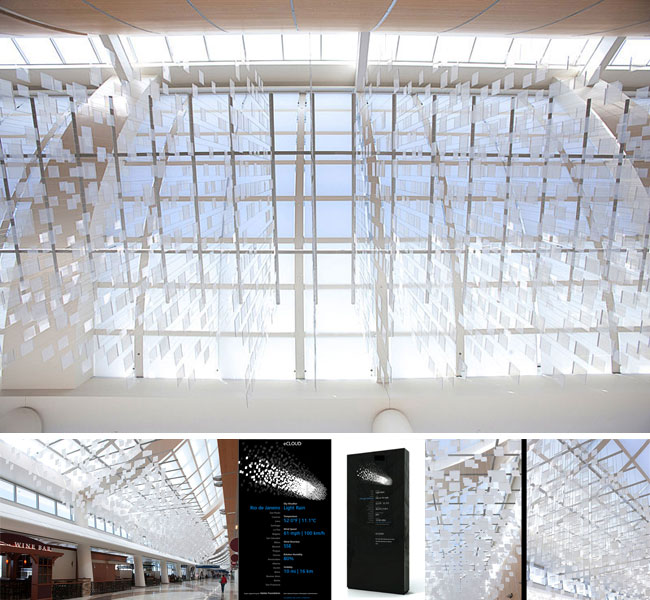
eCLOUD Project
Installed in the San Jose International Airport eCLOUD is a permanent art work by Aaron Koblin, Nik Hafermaas and Dan Goods. It is constructed from polycarbonate tiles that fade in between transparent and opaque states and are controlled by real time weather from NOAA from locations around the world. This data is used to create a simulation representing weather from any of the international locations by turning the individual tiles on and off in a certain pattern. The simulation is visualized within the cloud sculpture as well as on a dynamic display placed at eye level in the terminal.

Designed by Soo-in Yang and David Benjamin of The Living where one of their overall goals is to provide architecture and facades that inform, are functional, and begin to use data to become more efficient. This project is placed in a public park in Seoul and was created with a skin of panels whose shape mimics the shape and districting of the city. Every 15 minutes, the neighborhood panels light up in order of best air quality to worst based on 27 real-time sensors provided by the Korean Ministry of Environment. Neighborhoods are also illuminated if the air quality is better on that particular day than the same time last year and individuals can text message in to check pollution data and see their interaction show up on the map.
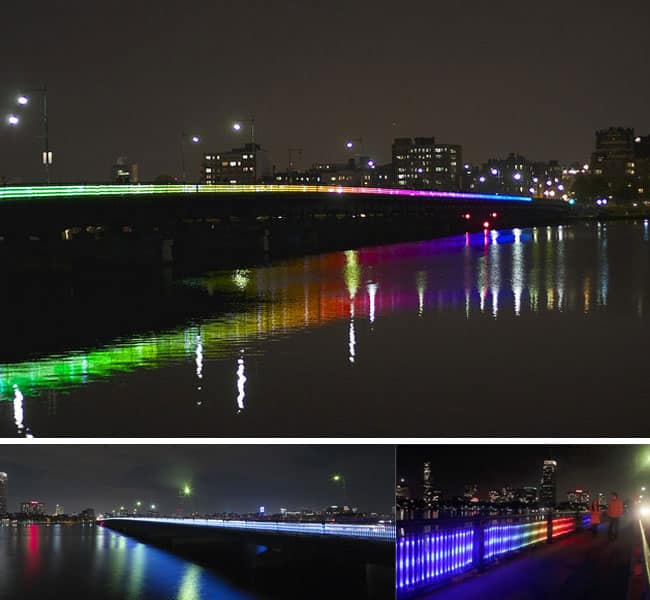
LightBridge is a project recently installed on the Harvard bridge by Susanne Seitinger a researcher in the Program in Media Arts and Sciences at MIT and Pol Pla a graduate student in the Program in Media Arts and Sciences. Susanne's recent Ph. D. was titled Liberated Pixels: Alternative Narratives for Lighting Future Cities and explored the aesthetic and interactive potentials for future lighting and display infrastructures.
The LightBridge installation is made up of a 10,000 pixel display activated by a variety of sensors including proximity sensors, cameras, buttons, mobile phones, and microphones. The work also allowed for community participation by having people visit a website and design their own interactive light effects in advance and then experience the designs during its opening days.

Matt Roberts is a new media artist specializing in real-time video performance and is currently the founder of MPG a Mobile Performance Group. This specific piece called 'Waves' responds to the current size and timing of the changing conditions of the sea. Every half hour the current ocean buoy station data from the nearest location to the installation is downloaded and the data is transformed into a low frequency sound wave. As the size and timing of the waves in the ocean changes so does the frequency of the sound waves which are made to shake a bowl of water sitting on top of a speaker and then projected onto a nearby wall.

Created by Tom Keene and Kypros Kyprianou Aristotle's Office is an installation where a group of 9 objects can can be connected by the user (in pairs) through a patch-bay. Once connected, the objects begin to talk to each other and negotiate who's in charge. Each of the objects (which include a light, a fan, a filing cabinet, and an office plant) has the ability to detect changes in the physical status of the objects they are plugged into, and, using simple rules, react accordingly to what is happening around them. The project seeks to ask questions like; How will the office plant respond to the advances of the fan? How does a water-cooler behave with an office light? and overall seeks to understand how our relationship with our objects will evolve as they slowly begin to talk in this coming age of the Internet of Things.
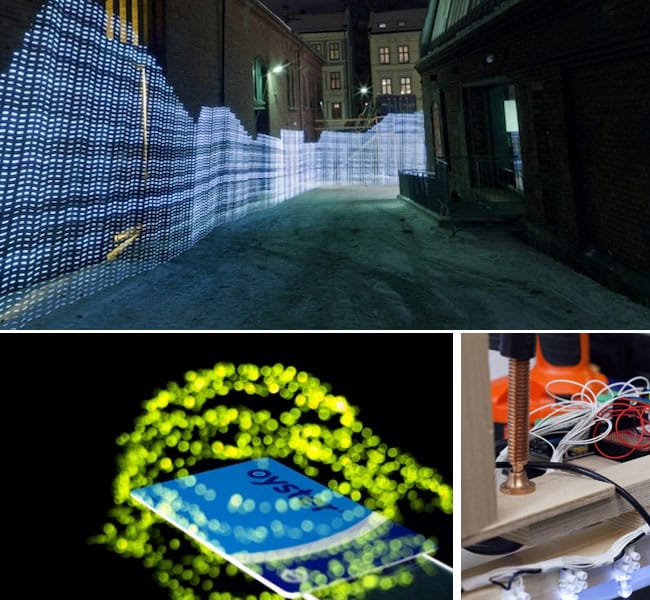
The Immaterials project was created by Timo Arnall, Einar Sneve Martinussen, and Jack Schulze from BERG and is part of the larger research initiative Touch that investigates and develops applications that enable people to interact with everyday objects and situations through new technology. The team has so far put their focus on engaging RFID, NFC, and WiFi and although they might not classify themselves as artists these projects suggest otherwise and point ahead to interesting visualizations and engagments with our digital environments.

Created by Mark Hansen and Ben Rubin Listening Post is an installation that pulls text fragments in real time from thousands of chat rooms, bulletin boards and other public forums online. The text is then displayed across a suspended grid of screens and sung or spoken by a voice synthesizer. The art is "a visual and sonic response to the content, magnitude, and immediacy of virtual communication."
View more of Ben's work here.

The British artist Stanza uses environmental sensors measuring, light, noise, sound, humidity, and temperature that are scattered all over the museum and in the surrounding city to make visualisations and sonifications in the gallery and demonstrate the current 'emotional' state of the city. With Sensity 'Instead of adopting narrative threads from other media, I am interested in the currency that exists already in the city space. These works are focused on the wider picture of city experiences which are being played out in real time.'
View more of his work here

HeHe is a Paris based art and design studio by Helen Evans and Heiko Hansen and their project "Nuage Vert" or 'Green Cloud' is using a city-scale light installation to alter perceptions on pollution and increase participation among the cities local population.
One of their projections takes place near Ruoholahti in central Helsinki. The Green Cloud uses the chimney emissions of the Salmisaari power plant which can be seen for miles as a canvas. A high power laser beam illuminates the plume at night with the size of the projection being determined based on the current energy usage of the local community.
A video of the project can be seen here:

David Bowen's Tele-Present Water installation draws information from the movement and intensity of the water in real-time from National Oceanic and Atmospheric Administration (NOAA) data buoy station 46075 in the Shumagin Islands, Alaska. It then displays this information on the mechanical grid structure in the gallery through the use of an Arduino mega running servo firmata and using an 11 x 24 volt dc motor with drivers.

Although static in its display the Plunge Project by artist Michael Pinsky is a colorful example of using civic space and data to engage the public in a conversation by showing Londoners what their city and landmarks will look like when covered by the expected water levels of 3111.
A collaborative effort between the artists, Artsadmin and London International Festival of Theatre (LIFT) Blue LED rings will be wrapped around famous London monument's Duke of York Column, the Paternoster Square Column and the Seven Dials Sundial Pillar and invites us to "look again at some of the monuments in the capital, to think about their history and how to protect their future."

City Fireflies is an installation created by design and technology collective UNCODED for the facade at the Prado MediaLab in Madrid.
The game functions by using light from cell phones as controllers that remove the "threats" that are attacking and trying to take over the urban plaza. As the game progresses the threats become more difficult to defeat so more players and phones are needed to join in on the action turning the game into a multiplayer collaborative effort.
According to the creators of the project Victor Diaz and Sergio Galán the system was designed to explore new ways of engaging in public spaces that are accessible to almost anyone without a complex set of instructions or the need to maintain and manage a separate system of game controllers.

Artist David Bowen continues his explorations into a networked world (See: tele-present water) with his latest project Fly Tweet that enables a swarm of common houseflies to speak via Twitter.
The flies live inside an acrylic sphere containing a standard computer keyboard and as they interact inside their home their movements are collected and analyzed in real-time via video. As a particular key is triggered by the aggregated movement the corresponding character is inputted into a twitter text box. If the flies trigger the return key the latest message containing the accumulated characters is tweeted or if a full 140 characters are reached before the enter key is activated a message is automatically sent out to all 82 (as of April 17) of the swarm's followers.

Created by the design collective YesYesNo and iDigi "Connecting Light" is an art installation installed alongside Hadrian’s Wall as part of the London Games 2012 Festival.
The installation is composed of hundreds of 6' tall connected balloons that illuminate one of Britain’s greatest Roman monuments: Hadrian’s Wall - a defensive structure once reaching a length of 120km and dating back to 122 AD that is now a World Heritage Site. The balloons use Programmable XBees, GSM mobile routers and LED lights to transmit colors from one balloon to another along the wall, creating a communication network that spans over seventy miles.
Visitors to the wall and online members are invited to participate by sending personalized messages to be displayed via the balloons at a number of viewing locations along the wall, or through a mobile app or on the web.

Created by designer Revital Cohen whose work explores the juxtaposition of the natural with the artificial comes the Artifical Biological Clock.
The work was featured in the Talk to Me exhbit at MOMA and is supposed to be given to a woman by her parents or partner. The object is fed information from her doctor, therapist and bank manager via an online service and when she is physically, mentally and financially ready to conceive the object awakes, seeking her attention. Acting as a "constant reminder of the temporary and fragile nature of fertility."



Casa Jasmina is not your typical bed-and-breakfast.
For one thing, the apartment is located on the upper floors of a repurposed Italian factory; its neighbors are a co-working lab, a makerspace, and the national offices of the Arduino project. For another, it’s ground zero for a two-year experiment in building an open-source connected home -- an experiment conceived in part by futurist and science fiction author Bruce Sterling.
“A lot has already been said about the Internet of Things, so the time has come to attempt to live the dream,” writes Sterling, who will act as Casa Jasmina’s curator. The project will offer a different approach to the IoT, one which doesn’t focus on things or gateways or cloud services. In Sterling’s words, Casa Jasmina will demonstrate “a user-centered model, a citizen-centered model, an open-source collaborative model.”
In building that model, Casa Jasmina will focus on contributions from the Italian tech community -- something the other co-founders, Massimo Banzi and Lorenzo Romagnoli, know a thing or two about. Both were involved in bootstrapping the country’s maker and FabLab scene, and Banzi is a co-founder of the Arduino project.
Italian inventors and designers will be invited to contribute hacks, prototypes and original tinkerings in exchange for brief “residencies” in the apartment. Companies will have the opportunity to sponsor the project, either by contributing products and equipment or by supporting the work of other designers in exchange for visibility.
Open Source Connected Living: Casa Jasmina
Eventually, Casa Jasmina will be available as a short-term rental apartment on Airbnb. The idea is not only to showcase the various contributions, but to provide the opportunity for anyone to experience a “smart” living space. And that means Casa Jasmina’s focus, especially for Sterling as curator, is on projects and products that explore what it means for connected objects to integrate successfully with our mundane, everyday lives.
Sterling writes:
Our first piece of household furniture is already chosen: it’s “Pietro Micca,” our pet Roomba robotic vacuum cleaner. I chose this vacuum cleaner as our mascot, not because it’s “high tech,” but because the Roomba line is ten years old, well-established, a living reality of domestic home automation. “Pietro Micca” will be martyred, because we are going to hack him relentlessly, but he represents “normal life.” That’s what we want to see and display in Casa Jasmina — the “normal life” of about ten years from now.
The vision is for Casa Jasmina to be a comprehensively smart home, with IoT technologies infusing everything from the furniture to the garden.
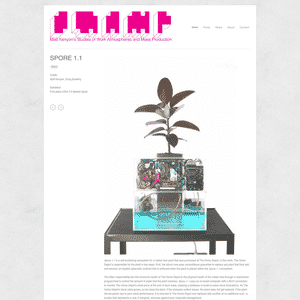
Spore 1.1 is a project created by SWAMP (Studies of Work Atmosphere and Mass Production) a studio founded in 1999 by artists Douglas Easterly and Matt Kenyon. In this project the life or death of a rubber tree plant is tied directly to current market forces.
Wi-Fi signals are like water, information mined from the internet is food, and electronic pulses become sunlight.
The project consists of a Home Depot purchased plant hooked up to a self-contained watering mechanism and calibrated on a weekly basis via Wi-Fi according to the performance of Home Depot's stock. If the Home Depot stock is doing well the plant gets its proper water supply. If on the other hand Home Depot's stock does poorly the plant does not get watered. If the plant should end up dying due to poor stock performance, it is returned to the Home Depot and replaced with another at no cost due to Home Depot's one year plant guarantee policy.
"The premise of Spore 1.1 is to expose choice and convenience as mechanisms of control. Data is gathered from a corporation (the collective exhaust of various human, cybernetic and social activity) and then used to effect the rubber tree plant, consequently expressing a viewpoint regarding the relationship between the individual and corporation."
The results of the duo's experiment with the plant?
"Home Depot’s stock ratings varied the whole time of the project. In November and December, however, Spore1.1 received water on 8 consecutive weeks. Its health seemed to steadily deteriorate after that, as its roots became rotted, and eventually died in January 2004. This was an unexpected result, as we assumed a weekly 1 minute watering would not kill the plant, rather only a lack of water would kill it. But it somehow seemed appropriate that the plant would die because of an overabundance of Home Depot stock gains"
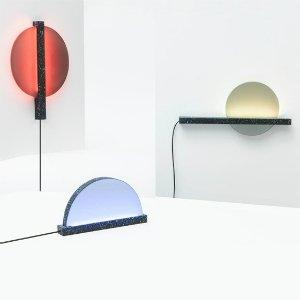

Patch of Sky is a project from a group of designers (Leonardo Amico, Federico Floriani, Reda Jouahri, Alice Longo, Akshataa Vishwanath and Giorgia Zanellato) based out of Italian design research center Fabrica that puts an atmospheric spin on ambient lighting.
It’s a set of minimalist abstract lamps named for Egyptian deities: Amun, the god of wind; Set, the god of storms; and Tefnut, the goddess of rain. All three lamp designs use mirrors and LEDs to represent weather conditions, drawn from a user’s location via their Facebook account.
The project is described as a way for family and friends to stay connected in some small way to the lives of distant loved ones, but it would also be useful for a traveler or commuter to have a pair of these lamps for the home and office.
Eleven different weather patterns can be represented by color gradients and simple animations, to cover all the seasons. For the most part the displays are subtle and intuitive, but a few involve more active flashing of lights. The lamps are powered by Arduino chips, with a BERGCloud module and bridge providing connectivity.
Patch of Sky is a design prototype, not currently available for purchase. But there are a number of ambient lighting displays on the market, as well as some DIY projects, that can provide a similar remote weather connection. See the links below for examples, and visit patchofsky.info to learn more about Patch of Sky.

The ability to wiggle one’s ears is a rare and vestigial trait in humans, one of many such leftovers from the billions-years-long process of evolution. But with technology making it possible to wire up all sorts of robot prosthetics to our bodies, we may one day find a use for even the most pointless-seeming parts of our bodies.
That’s part of the premise behind Wing, an interactive installation by Russian media-artist Dmitry Morozov (a.k.a. vtol). Participants attach dermal miographic sensors to the skin around their ear. The sensors record muscle activity, which is communicated via an Arduino Uno to a large, wing-shaped robotic sculpture. Regular movements of the ear-wiggling muscles, which in other animals allow the ears to swivel, are translated into a slow flapping motion that resembles a mechanical bird in flight.
Morozov describes the project as “an ironical and at the same time serious research on the topic of development of new instruments and prostheses as ‘extensions’ of human body and accordingly its possibilities and potentials, which are being revealed by new technologies.”
I know from first-hand experience that even though I can wiggle my ears, it often takes a frustrating amount of conscious effort to actually do so. It’s a bit like learning to control a brand new limb — which is essentially what robotic prostheses offer us. Morozov chose such an under-used muscle group in part to force participants to embody the spiritual practices of mindfulness and body awareness through a technological interaction. “It’s an attempt to stimulate people to perceive and train the body in a different way, expanding the limits of self-control and self-organisation in order to adapt to the new conditions,” he writes.

Keepalive, a digital installation in the countryside near Neuenkirchen, Germany, could easily be mistaken for a strangely charred but otherwise ordinary boulder. But in an unusual mashup of neolithic and digital technologies, lighting a fire up against the stone reveals a hidden cache of digital information.
Inside the rock is a thermoelectric generator that turns heat into power for a Wi-Fi router and USB drive. Visitors who activate and connect to the router gain access to dozens of digital survival guides on a variety of topics. Dating and intimacy, programming and hacking, parenting, shopping, dealing with bad bosses — everything one needs to know to weather the wilderness of contemporary culture.
The cache is powered by the Piratebox file-sharing software, and visitors are encouraged to add new survival guides of their own before the flames die down and the network goes dormant again. The title “Keepalive” not only refers to this compendium of life-saving information, but is also the term for content-free messages that two network endpoints exchange while maintaining an open connection.
As a commentary on the nature of networked objects, Keepalive is full of contradictions. Without a persistent power source or an Internet uplink, Keepalive can’t be accessed via remote connection. Only by visiting a remote physical location and engaging in the atavistic process of building a fire do we discover the boulder’s private network and its contents. Yet most of the information the rock reveals becomes relevant only when we return to civilization and its pervasive social and digital networks.
Keepalive is the creation of Aram Bartholl, and was commissioned by the Center for Digital Cultures at Leuphana University Lüneburg. It was installed at theSpringhornhof Foundation & Art Association in August 2015. To minimize the risk of wildfires, visits to Keepalive must be scheduled with Springhornhof in advance.

Articulated Surface is a project created by three students (Justine Holzman, Ji Park and Luke Venable) for their Responsive Systems course at LSU’s Landscape Architecture program. The proposal uses real-time data from the Atchafalaya River Basin to create a dynamic art installation and public space in the city of Baton Rouge.
The design represents a data visualization of dissolved oxygen [DO] content using a dynamic surface and light system that responds and adjusts to the data. Some factors that influence the structure and contribute to high and low areas of dissolved oxygen include the river’s water temperature, stage height, current velocity and water depth.
“A relationship would form between the state of the structure and the time of day, time of month, seasonal changes, flood pulses and water stage height. Areas amplified by current velocity and higher levels of DO would create pathways for pedestrian movement and open areas for gathering in the public space”.
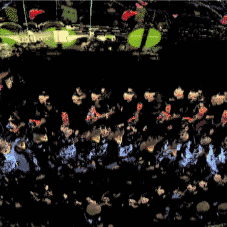
Color Forecast is an app and website developed by fashion brand Pimkie that shows you which colors are trending in Europe’s fashion capitals in real-time. Video cameras were placed strategically in high fashion/traffic areas in Paris, Milan, and Antwerp and then fed back into a system developed by interactive artist and developer Pedro Miguel Cruz that collects the data, creates a visualization of the trend, and also links to an item of clothing matching the color from the Pimkie collection that can be purchased online.
Data can be retrieved in real-time or you can see if a specific color is trending over a given day or week. A short video description of the project is embedded below or you can check out the live feed yourself at:http://www.pimkiecolorforecast.com/




Twitter is named for bird song — so what would happen if you turned tweets into music? That’s the question explored by Social Vibes, a musical installation that analyzes real-time social media content and translates Twitter users’ emotions into musical notes. It was created by Cian McLysaght, a master’s student of interactive media at the University of Limerick, Ireland, starting in 2013.
The Vibe is essentially a custom-built vibraphone — a mahogany frame holding a collection of aluminum keys, copper resonating tubes and motorized valves and strikers. It’s all controlled with an Arduino running a sketch written in the programming language Processing.
As tweets come in through the global stream, the instrument looks for emotional keywords: anger, anxiety, desire, despair, fear, hate, hope, happiness, love, sadness, shame and surprise. Each one is mapped to a specific note across four octaves, which allows groups of similar emotions to occupy an appropriate part of the scale with plenty of dynamism between the unpleasant lows, the appealing mid-range, and the intense highs. The faster the tweets roll in, the more quickly the notes are struck.
Mostly the Vibe sounds like a wind chime ringing randomly in the digital breeze, but Twitter users can send direct tweets to @vibe_experiment to have it play their own emotional compositions.
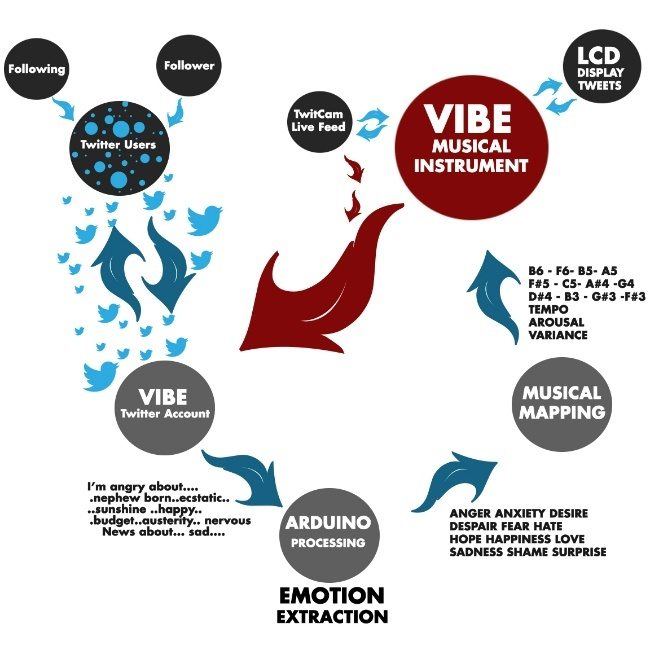
Like many other connected art installations, Social Vibes makes tangible an aspect of the digital infrastructure and content that flows around us at all times, unseen but influential. It also plays with the concept of emotional expression in music. Usually emotion flows intentionally from the artist into the composition and performance, which in turn stirs the emotions of the listener. Here, the people whose emotions inform the composition are largely unaware of their contribution, and listeners can be active participants in shaping the emotional-musical interaction.

The creation of design firms Urbain DRC and INVIVIA, MIMMI (Minneapolis Interactive Macro-Mood Installation) is an inflatable sculpture installed in the plaza of the Minneapolis Convention Center that captures and displays information from the activity levels in the surrounding area as well as aggregating the general sentiment of the cities residents using real-time Twitter data.
The innagural winner in the cities Creative City ChallengeMIMMI uses open source textual analysis tools to determine if a tweet sent from within a 15 mile radius of the Convention Center has a positive or negative focus. Using a 4,000 word database each Twitter message is connected to a certain color, if the aggregate mood is negative wifi-enabled LED bulbs inside the sculpture will display cool colors and if more positive will shift to warmer tones. The rate of the how fast the mood is shifted depends on the rate of Twitter posts being sent.
Visitors to the plaza also shape how MIMMI reacts. An integrated water misting system creates a cooling microclimate around the sculpture during the daytime when people approach the sculpture and their proximity can shift the overall color display (and the collective city “mood”) in a warmer direction through their visit.
Whether the city is elated following a Minnesota Twins win or frustrated from the afternoon commute, MIMMI responds, changing behavior throughout the day and night.



Additional: Competition details, Minnesota CBS Related: Networked Art, Green Cloud, Connecting Light Image Credits: Meet Minneapolis

You pull out your phone and open a map. A blue dot appears, pinpointing your location. Here you are, the dot says. It’s reassuring, accurate, reliable…mostly. But every now and then, the unity of self and dot falters. The dot skips away across the map, wandering drunkenly about while you stay rooted firmly to the ground. Eventually, the dot finds its way back to your location, but not before your faith in the conformity of the digital with the real has been stirred.
GPS, the global positioning system, is a bedrock technology of the Internet of Things, one of the earliest ways of representing real-time data about connected devices and objects. We’ve come to rely on it in our daily lives, trusting in mapping software to help us navigate the world, find our friends, and explore distant places.
But in the parable of the dancing dot, the limitations of GPS are laid bare. GPS relies on a network of satellites orbiting 12,000 miles above the earth. At any particular spot, the signals from these satellites grow weaker and stronger as they pass overhead, and it’s those fluctuations that cause the phantom movement of your wandering blue dot.
Satellite Lamps, a project of design researchers Einar Sneve Martinussen, Jørn Knutsen, and Timo Arnall at the Oslo School of Architecture and Design in Norway (also the group behind the ImmaterialsWiFi and RFID exploration in 2009), illuminates the changeable nature of GPS signals. Each lamp is attached to a GPS receiver, but instead of triangulating its location, the brightness of the bulb represents the strength — and therefore the accuracy — of the signals it receives.
In time-lapse videos, some lamps shine bright while others flash fitfully between off and dim. Even in a single location, a lamp placed too near a building or overpass may struggle to find a signal while its twin, just a few feet away, glows happily. The fickle flicker of the light mirrors every juke and sidestep of the ubiquitous blue dot, providing a tangible reminder that GPS, like all digital technologies, can only represent the world as accurately as we can measure it.


As designers, the trio behind Satellite Lamps want to encourage new ways of thinking about a technology that remains largely invisible.
“GPS is symbolically underdeveloped,” they write at the end of an essay that accompanies the project. “It’s a sophisticated technology, but we haven’t got an equally sophisticated language for understanding it. We end up with unhelpful folk mythology and development tools that limit the application of GPS to primarily locating oneself on a map.”
By creating a physical representation of the ever-present global positioning signals, Satellite Lamps is intended to “anchor a discussion about how GPS takes place in the city and everyday life, but also how we engage with the technology as designer. This, hopefully, reminds people of a taken-for-granted and out-of-sight technology, and opens it for new perspectives, critique, and further investigation.”
When it comes to the Internet of Things, design exists at the intersection of digital bits and the physical world. The trick for designers is to make the two overlap as seamlessly as possible — and as Satellite Lamps proves, that sometimes means making ourselves view familiar technology in a different light.

Natural Fuse is a project developed in 2009 by Haque Design + Research as part of the Architectural League of New York’s Exhibition, “Situated Technologies: Toward the Sentient City” that harnesses the natural carbon-capturing processes of plants as they grow, and uses it in combination with a standard household power socket (limited by the capacity of the plant to offset the carbon footprint) to generate a city-wide network of electronically-assisted plants that act both as energy providers and as circuit breakers.

“Natural Fuses allow only a limited amount of energy to be expended; that amount is limited by the amount of CO2 that can be absorbed by the plants that are growing in the system – natural “circuit breakers”. By networking them together, the plants are able to share their capacity and take advantage of carbon-sinking-surplus in the system since not all Natural Fuses will be in use at any one time.
If people cooperate on energy expenditure then the plants thrive (and everyone may use more energy); but if they don’t then the network starts to kill plants, thus diminishing the network’s electricity capacity”

Learn more at: http://www.naturalfuse.org/ or for background on the design process and experiments you can download the Research Book produced here (PDF) .
Additional Coverage: Instructables, DesignBoom, Usman Haque Video, Sentient City, Presentation Video
Matthew Fuller interviews Usman Haque about the project: Link

Unnumbered Sparks was a large, interactive sculpture installation on display at the 30th anniversary of the TED conference in Vancouver, Canada, during March 2014.
The sculpture, a net-like canvas 745 feet long and suspended between downtown buildings, was created by artist Janet Echelman. Aaron KoblinCreative Director of Google’s Data Arts Team created the digital component, which allowed visitors to collaboratively project abstract shapes and colors onto the sculpture using a mobile app.
Koblin explains that a viewer is actually seeing a “distributed website” when interacting with the sculpture. Created using a combination of WebSockets, JavaScript, and Polymer and used to show off Google Chrome’s latest capabilities (You can try it out as a 3D simulation at the project’s website) visitors were able to choreograph the lighting by simply connecting to the local WiFi network and deciding where on the sculpture they would like to leave their mark.
Projection mapping technology translated their actions onto the correct location of the shifting fibers in real-time.



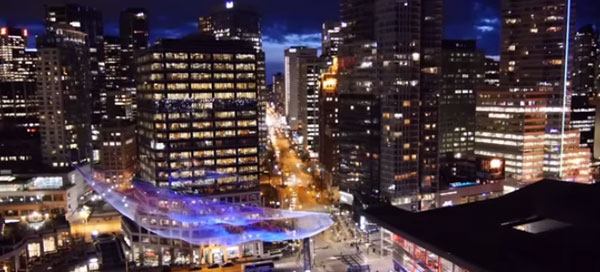
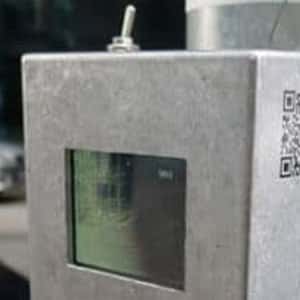
Benjamin Gaulon, aka Recyclism is an artist, researcher and lecturer at the National College of Art and Design in Dublin. In his 2.4 GHz project he uses a wireless video receiver to hack into 2.4 GHz wireless surveillance cameras placed around the city and displays this footage back to the observed at street level.
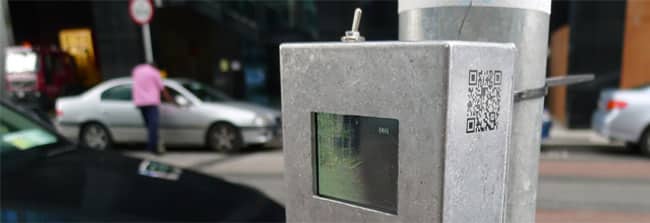
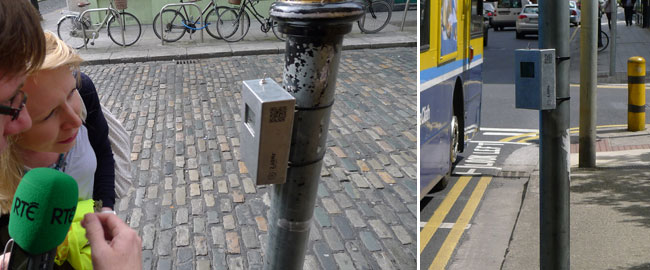
According to Benjamin he is pursuing three major initiatives within the project. First, he’s traveling around Europe on his own to collect and publish footage captured using his receiver device (As seen below). Second, he is placing the broadcasting devices on street infrastructure to reveal to the public the presence and ability to capture this type of monitoring footage. Finally, he is holding a series of 2.4 GHzworkshops that invite local residents to explore their own neighborhoods and cities to search for 2.4GHz surveillance video signals and map these online using a Google map for others to explore.


An additional element of the project brought up by the artist is that not only are surveillance cameras using this type of technology but it is also being integrated into consumer products like home baby monitoring devices. Many people may not be aware that they could be broadcasting this signal out to the world.

Tomorrow is Another Day is a piece by Mathieu Lehanneur that gathers real-time weather data from the Internet to generate a picture of the future sky.
Conceived for the palliative-care unit at the Diaconesses/Croix-Saint-Simon Hospital Group, in Paris and created using an LED Screen, acrylic lens and honey comb polycarbonate so that patients in the unit could use the device to in the designer’s words to “elude the course of time by offering everyone the opportunity to see tomorrow’s sky.”

Do you recall the ViewMaster toy by FisherPrice? You looked through pseudo-binoculars at slides of far away places or events while sitting on the living room couch. Well, Turn To Clear Vision has reinvented that experience at much higher, more technical level.
Taking a common sightseeing view tower, Dave Rauchwerkand a diversely talented team have replaced the visual field with a monitor. What shows up on the monitor is connected to cameras in a remote location that adjust to the rotations made by the user looking through the view tower. “Two potentiometers on the telescope relay pan and tilt data to a series of remote cameras and servos via web sockets.” What you see can be as close as around the corner or on the other side of the world. But the tactile experience and the visual field are as real and present as if it was all analog.The idea came about as part of the Urban Prototype festival in San Francisco.


Future prototypes look to use wireless networking such that cameras can be placed anywhere in the world and linked to the view towers. With view towers placed in points-of-interest sites in a given town, anyone could look through expecting to see some landmark only to discover, say, the Taj Mahal or Time’s Square.
Why should this matter? Not only are the creators playing with our notions of expectation, but they are reshaping how we see the world at large, the world beyond our immediate location. And they are doing it by integrating technology with a familiar analog interface.

Res Sapiens a project by Pieke Bergmans & LUSTlab features common desk lamps connected to the internet.
The 13 lamps were exhibited in Milan recently where they used a “continuous stream of (public) digital data and information as their mental energy, meeting each other on their own social network. They inform you like facial expressions based on their personal surroundings, your behaviour and input, and the state of affairs of all other lamps. They can light up and project, be moved and move by themselves. They fuse product and information design, making technology invisible, working and building on humanizing the unhuman.”
The lamps are reacting to news headlines and twitter posts by identifying; negative, neutral, or positive key words. Then they move around and switch their lights on/off according to these headlines and key words.
You can interact with one of the lamps directly via Twitter @ressapiens
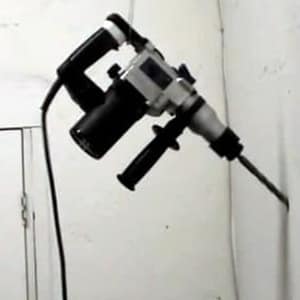
Alerting Infrastructure is a 2003 project by artist and professor Jonah Brucker-Cohen that takes the number of visitors to a gallery/organizations web site and translates those hits into physical damage to the building via a pneumatic jackhammer that the web site is representing.
“The amount of structural damage to the building directly correlates to the amount of exposure and attention the web site gets, thus exposing the physical structure’s temporal existence……This way visitors to the physical space can get a sense of how many online visitors have come and gone and experience their presence as the walls slowly deteriorate.”
In an interview with Vague Terrain Jonah comments:
“I don’t think I’m purposely trying to remap one data to another medium, but I am interested in using electronics and physical objects to show characteristics of networks through both user input and activated output. I am interested in bringing about awareness to our dependence on networks by amplifying these elements of networks such as our connection speed, the metaphors that surround networks and their connectivity, the clichés associated with them, and how they are represented in popular culture and the media.”


More of Jonah’s work can be seen at: coin-operated.com or you can watch Alerting Infrastructure! in action below.

The Selfie Plant: Social Media Flowerpot
We’ve covered a lot of smart gardening products over the years, including flowerpots that can take care of their own watering. But The Selfie Plant, a project from several students at the Copenhagen Institute of Interaction Design, takes the smart garden in a different direction.
Instead of checking weather forecasts and reminding the plant’s owner to care for it, the Arduino Yún-powered vessel uses its Internet connection to create a social media presence. It even gives the plant its own “selfie stick” in the form of a motorized arm. Combined with a rotating platform underneath the flowerpot itself, this allows the plant to pose and preen for the camera — and post the photos to Facebook, of course.
“The Selfie Plant expresses itself in the form of a nice-looking selfies, which it clicks according to its mood, weather or occasion,” write Shruti KNR, Haoyu Li and Manu Dixit. “It mimics human behaviour, by giving it’s best pose and adjusting the camera angle to take the perfect selfie.”
The students’ goal is to explore how selfie culture can be applied to our interactions with nature. What if a plant “could record moments like blooming of a flower or a new leaf, and then share these moments on the social network,” they wonder. Perhaps this form of inanimate self-expression “might be able to draw public attention and would act as a bridge between humans and nature.”
While becoming Facebook friends with a potted flower could rightly be seen as frivolous, it would be interesting to see how the Selfie Plant concept could be applied towards broader trends of device agency in the marketplace, or larger social issues like conservation efforts. An autonomous social media presence attached to an ancient tree in a rainforest threatened by clearcutting, or a melting Antarctic glacier, might allow people to form a daily personal connection to environmental problems like deforestation.
